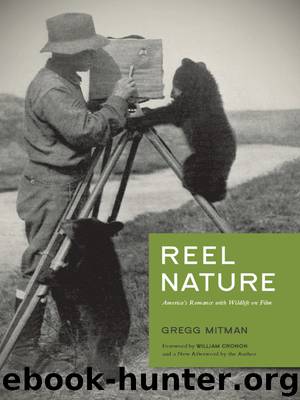Reel Nature by Mitman Gregg

Author:Mitman, Gregg.
Language: eng
Format: epub
ISBN: 9780295803722
Publisher: University of Washington Press
Through Zoo Parade and spin-offs, including a nationally syndicated newspaper column, a Dell comic book series, and a product line of Marlin Perkins's Zoo Parade Tooby Toy Animals, Perkins and his animal friends became national celebrities. Other animal stars soon rivaled the place of Bushman, Heinie II, and Sinbad in the hearts of children, however. In the 1954 fall season, ABC and CBS introduced The Adventures of Rin-Tin-Tin and Lassie on early Sunday evening.28 Lassie, which surpassed rival Rin-Tin-Tin in ratings and fan mail, attracted 25 million viewers, received consecutive Emmy awards in 1954 and 1955 for the best children's program, and sold oceans of Campbell's soup. Although neither Lassie nor The Adventures of Rin-Tin-Tin competed with Zoo Parade's late Sunday afternoon time slot, this new television format of sentimental adventure told through the exploits of a boy and his dog plucked at the heart-strings of children and nostalgic parents and outclassed the emotional appeal of even the most adorable zoo animals. Sinbad or Sweet William might draw laughs, but they couldn't easily evoke an “honest-to-goodness” cry, which Robert Maxwell, producer of Lassie, gave as the reason why audiences found the program so memorable.29
In focusing on particular charismatic animal species that had pet-like appeal, Perkins subtly preached a conservation message by helping audiences identify with animals in the natural world. In the early years of Zoo Parade, Perkins often debunked myths and stereotypes about various animals such as coyotes, wolves, and crows deemed to be either harmful or a nuisance to humans.30 In contrast, Lassie's occasional perpetuation of prejudice against the value of certain wild animals led the American Nature Association to mildly rebuke the show for having “muffed” an excellent opportunity to teach children the lessons of wildlife conservation. In a 1956 Lassie episode, trouble came to the farm when young Jeff tamed a red-tailed hawk. After Gramps discovered the hawk inside the barn and his chickens killed, Jeff accepted the wisdom of his grandfather's adage that the “only good hawk is a dead hawk” and poisoned the bird himself. Thinking at first that the script writers would have Gramps discover “that a weasel or large rat had killed the fowl, thus absolving the hawk, the most beneficial of his kind,” the editor of Nature Magazine, when proved wrong, felt “disappointment” and “disgust” in the nature lessons learned. As television shows like Lassie offered entertainment through more familiar animal companions, Zoo Parade began foregrounding other approaches in educating television audiences about the value of wildlife, approaches that didn't rely solely upon wild animals’ similarities to domestic pets.31
Other changes in television programming also prompted a shift in Zoo Parade's format. By the mid-1950s, Zoo Parade's audience numbers fell from its peak of 11 million viewers in 1952. In the fall of 1956, when television reached into 72 percent of American homes, the audience for Zoo Parade had fallen to an estimated 7 million fans. Ken-L-Ration dropped sponsorship of the program in 1955. The show went through three different sponsors—Quaker Oats,
Download
This site does not store any files on its server. We only index and link to content provided by other sites. Please contact the content providers to delete copyright contents if any and email us, we'll remove relevant links or contents immediately.
The Kite Runner by Khaled Hosseini(4413)
Gerald's Game by Stephen King(3913)
The Perils of Being Moderately Famous by Soha Ali Khan(3781)
Dialogue by Robert McKee(3574)
Story: Substance, Structure, Style and the Principles of Screenwriting by Robert McKee(2981)
The 101 Dalmatians by Dodie Smith(2931)
The Pixar Touch by David A. Price(2735)
Confessions of a Video Vixen by Karrine Steffans(2668)
Fantastic Beasts: The Crimes of Grindelwald by J. K. Rowling(2539)
How Music Works by David Byrne(2519)
Harry Potter 4 - Harry Potter and The Goblet of Fire by J.K.Rowling(2413)
Slugfest by Reed Tucker(2411)
The Mental Game of Writing: How to Overcome Obstacles, Stay Creative and Productive, and Free Your Mind for Success by James Scott Bell(2388)
Wildflower by Drew Barrymore(2114)
Scandals of Classic Hollywood: Sex, Deviance, and Drama from the Golden Age of American Cinema by Anne Helen Petersen(2104)
Casting Might-Have-Beens: A Film by Film Directory of Actors Considered for Roles Given to Others by Mell Eila(2071)
Screenplay: The Foundations of Screenwriting by Syd Field(2051)
Robin by Dave Itzkoff(2002)
The Complete H. P. Lovecraft Reader by H.P. Lovecraft(1970)
